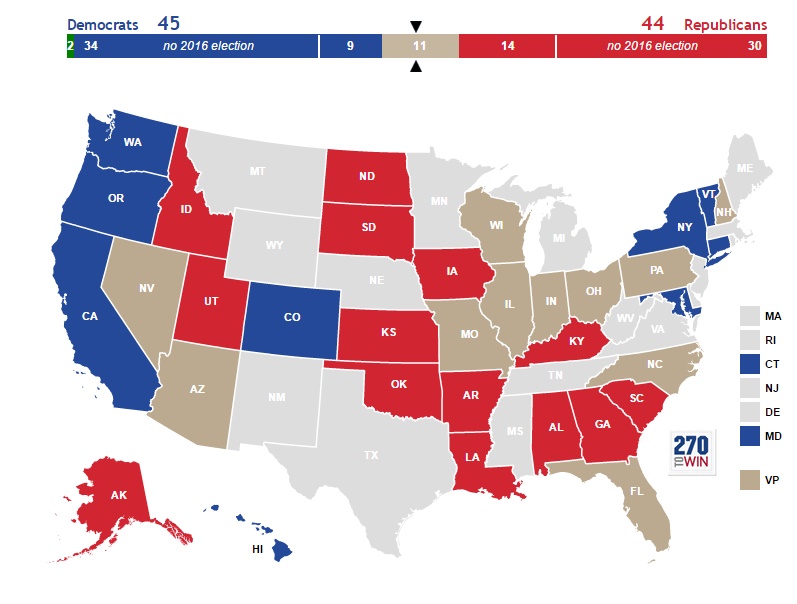The presidential election has taken up most of the public’s attention, but it is not the only interesting political battle this cycle. While the House of Representatives will likely remain in Republican hands, the Senate is up for grabs. The outlook at this point is roughly 50-50 for either party to take control. Here’s how the math breaks down.
The public will elect 34 senators this cycle. These are the seats being contested. Here’s a handy map from 270towin.com visualizing it:

This map is a challenge for the GOP. 24 Republican-held seats are up for election, compared to only 10 Democratic seats. Senate elections run in six-year cycles, so the Republicans are defending all the gains they made in 2010, including eight seats from states Obama won in 2012. On the other hand, Democrats must defend only a handful of seats, mostly in blue states, as they lost just about everything else in 2010. There are zero Democratic seats in play from states that Mitt Romney won.
This geographical challenge for the GOP is compounded by the relative popularity of President Obama, whose job approval is near its highest point in his second term, and the unpopularity of Donald Trump. Hillary Clinton’s unpopularity mitigates this, to some extent, but the net result of all these forces is a pickup opportunity for the Democrats. The question is how many seats they can get.
The GOP currently holds 54 Senate seats, which means it can afford to lose 3 seats and still be secure in its majority.
The latest Senate ratings from the Rothenberg & Gonzales Report give the Democrats an edge in the Republican-held seat of Illinois. Meanwhile, Florida, Indiana, New Hampshire, North Carolina, Pennsylvania, and Wisconsin are all “toss-ups” of one sort or another. The only Democratic seat in play is Nevada.
Matters could be much worse for the Republicans, as just a few months ago it looked like Democrats could win Rob Portman’s seat in Ohio. Now, he seems secure. Moreover, Marco Rubio is looking reasonably strong in Florida. On the other hand, Wisconsin is looking like a probable pickup for the Democrats.
In sum, it appears as though the Democrats have two Republican seats in the bag, and there are five genuine toss-ups: Indiana, Nevada, New Hampshire, North Carolina, and Pennsylvania.
Indiana is a peculiar case, for it was previously thought that Evan Bayh, the former senator who is running to return to the upper chamber, would be a virtual lock to win election. But a recent poll from Indiana-based Howey Politics showed him with just a four-point lead, and stuck at 44 percent. Given that Bayh is effectively running as an incumbent—he’s running for the seat he vacated just six years ago, and the man he is running to replace, Dan Coats, is retiring—this is not a great spot for him to be in.
Thus, 47 seats are leaning or solidly Democratic (or not up this election cycle), 48 seats are leaning or solidly Republican (or not up this cycle), and five are true toss-ups. If the GOP goes three-for-five among the toss-ups, and wins all the seats where it is currently favored, it will assuredly hold the Senate. If it goes two-for-five, then the Senate, split 50-50, will be controlled by whichever party wins the White House. (The vice president has the tiebreaking vote in the Senate.) If Republicans do worse than this, the Democrats will assuredly hold the Senate.
Different election models assign different probabilities to the outcome, but they are all in spitting distance of 50-50 for control of the upper chamber at this point.

